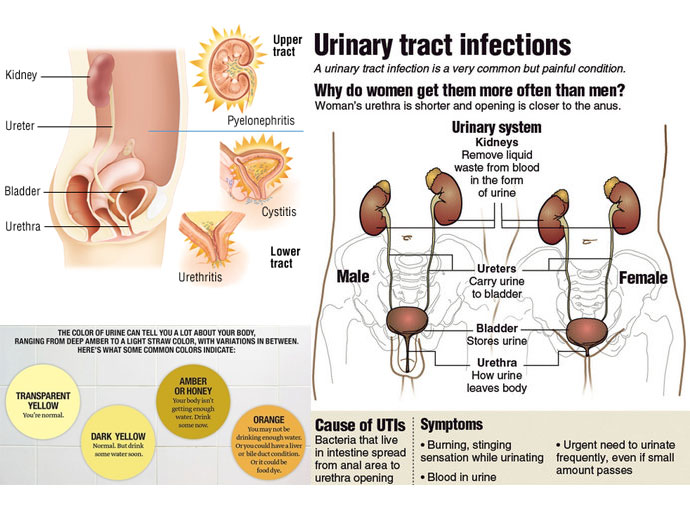Defination of urinary tract infection (UTI):
A urinary tract infection (UTI) is an infection in any part of your urinary system — your kidneys, ureters, bladder and urethra. Most infections involve the lower urinary tract — the bladder and the urethra.
Women are at greater risk of developing a UTI than men. Infection limited to your bladder can be painful and annoying. However, serious consequences can occur if a UTI spreads to your kidneys.
What Causes UTIs in Women ?
UTIs are a key reason we’re often told to wipe from front to back after using the bathroom. That’s because the urethra — the tube that transports urine from the bladder to the outside of the body — is located close to the anus. Bacteria from the large intestine, such as E. coli, are in the perfect position to escape the anus and invade the urethra. From there, they can travel up to the bladder, and if the infection isn’t treated, continue on to infect the kidneys. Women may be especially prone to UTIs because they have shorter urethras, which allow bacteria quick access to the bladder. Having sex can introduce bacteria into the urinary tract, too.
Symptoms of UTIs
To identify a UTI, keep an eye out for the following symptoms:
- A burning feeling, strong, persistent urge when you urinate
- A frequent or intense urge to urinate, even though little comes out when you do
- Urine that appears cloudy
- Urine that appears red, bright pink or cola-colored — a sign of blood in the urine
- Cloudy, dark, bloody, or strange-smelling urine
- Pain or pressure in your back or lower abdomen
- Pelvic pain, in women — especially in the center of the pelvis and around the area of the pubic bone
- Feeling tired or shaky
- Fever or chills (a sign the infection may have reached your kidneys)
The type of UTI depends on which part of your urinary tract is infected.
| Part of urinary tract affected | Signs and symptoms |
|---|---|
| Kidneys (acute pyelonephritis) | Upper back and side (flank) pain High fever Shaking and chills Nausea Vomiting |
| Bladder (cystitis) | Pelvic pressure Lower abdomen discomfort Frequent, painful urination Blood in urine |
| Urethra (urethritis) | Burning with urination Discharge |
Home remedies:
Urinary tract infections can be painful, but you can take steps to ease your discomfort until antibiotics treat the infection. Follow these tips:
- Drink plenty of water. Water helps to dilute your urine and flush out bacteria.
- Avoid drinks that may irritate your bladder. Avoid coffee, alcohol, and soft drinks containing citrus juices or caffeine until your infection has cleared. They can irritate your bladder and tend to aggravate your frequent or urgent need to urinate.
- Use a heating pad. Apply a warm, but not hot, heating pad to your abdomen to minimize bladder pressure or discomfort.
Tests, Treatments and drugs for UTIs :
If you suspect you have a urinary tract infection, head to the doctor. You’ll be asked to give a urine sample, which will be tested for the presence of UTI-causing bacteria. The treatment? Antibiotics to kill the intruders. As always, be sure to finish off the prescribed cycle of medicine completely, even after you start to feel better. And drink lots of water to help flush the bacteria from your system. Your doctor may prescribe a medication to soothe the pain, and a heating pad may also be helpful.
Antibiotics usually are the first line treatment for urinary tract infections. Which drugs are prescribed and for how long depend on your health condition and the type of bacteria found in your urine.
Simple infection:
Drugs commonly recommended for simple UTIs include:
- Trimethoprim/sulfamethoxazole
- Fosfomycin
- Nitrofurantoin
- Ciprofloxacin
- Levofloxacin
- Cephalexin
- Ceftriaxone
- Azithromycin
- Doxycycline
- Ofloxacin
Often, symptoms clear up within a few days of treatment. But you may need to continue antibiotics for a week or more. Take the entire course of antibiotics as prescribed.
For an uncomplicated UTI that occurs when you’re otherwise healthy, your doctor may recommend a shorter course of treatment, such as taking an antibiotic for one to three days. But whether this short course of treatment is enough to treat your infection depends on your particular symptoms and medical history.
Your doctor may also prescribe a pain medication (analgesic) that numbs your bladder and urethra to relieve burning while urinating, but pain usually is relieved soon after starting an antibiotic. One common side effect of urinary tract analgesics is discolored urine — orange or red.
Frequent infections:
If you have frequent UTIs, your doctor may make certain treatment recommendations, such as:
- Low dose antibiotics, initially for six months but sometimes longer
- Self-diagnosis and treatment, if you stay in touch with your doctor
- A single dose of antibiotic after sexual intercourse if your infections are related to sexual activity
- Vaginal estrogen therapy if you’re postmenopausal
Severe infection:
For a severe UTI, you may need treatment with intravenous antibiotics in a hospital.
Source : mayoclinic.org






